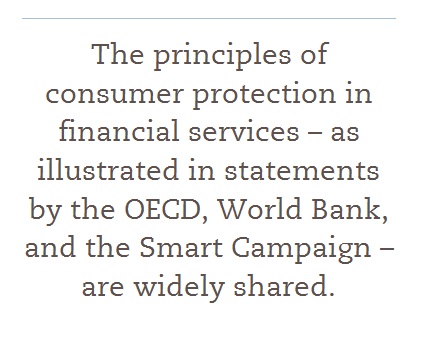Read the Roadmap below or download a PDF version here.
This Roadmap is also available in Spanish and French.
Have something to say? Share your thoughts and comments at the bottom of the page.
The Main Idea: |
|
With an enormous influx of inexperienced and vulnerable customers at stake, attention to consumer protection is needed now more than ever before. We can build on the strong consensus about the principles of financial consumer protection. |
The responsibility to protect consumers is shared by financial service providers, regulators and consumers themselves. |
Providers should make client protection a part of the core identity of the banking profession. Providers need to be proactive in applying shared standards and policing their own industry. |
Consumers will not be effectively protected without effective regulation. Yet, in many countries, client protection regulation is nascent or weak. There is an urgent need for major investments in effective client protection systems within the decade. |
A promising opportunity exists to empower customers to protect themselves, through financial capability building, consumer organizations and means such as publication of complaints data. |

Incentives that can lead to client abuses in financial systems are inherent in both human nature (such as cognitive biases toward over-optimism) and the competitive process. The challenge of client protection is not to eliminate these basic forces, but to reduce the power and information imbalances that enable harm, and to provide countervailing incentives or requirements for positive behavior. A balanced vision for client protection in a state of financial inclusion means that the incentives for poor behavior must be offset by an environment that gives consumers rights and protections.
Financial inclusion with client protection will occur when all clients can affirm the following:
- I have a range of quality financial services and providers to choose from.
- I can get the information I need to make a good decision.
- The choices I have are affordable.
- I have trust and confidence that using these products and services will not cause harm.
- I am treated with respect.
- I have rights as a client and know the paths to resolve problems.
The working group is exploring how to create structures that support client protection at four levels:
- Regulators, who are increasingly recognizing that client protection can contribute to financial system stability, and that an orderly marketplace with strong client protection can benefit providers as well as clients.
- Providers, who must take an affirmative attitude toward client protection rather than seeing it as something forced upon them by regulators. Initiatives such as the Smart Campaign which build industry-based commitment and capacity are encouraged.
- Clients and client groups, who also have a responsibility to know their rights and responsibilities and to advocate for effective client protections.
- Political will. The group calls on the world community to set a global goal of implementing client protection in every country by the end of the decade.
Working Group Members
Elisabeth Rhyne, Managing Director, Center for Financial Inclusion (Chair)
David Grace, Consultant, United States (Facilitator)
Michael Chapman, Senior Policy Expert, Organisation for Economic Co-operation and Development
Johanna Jaeger, Financial Sector Specialist, World Bank
Brigitte Klein, Head of Financial System Development, Deutsche Gesellschaft für Internationale Zusammenarbeit (GIZ)
Ashok Narain,Consultant, India
Karen Niederkohr, Consultant, United States
Andrew Pospielovsky, U.S. Consumer Financial Protection Bureau
Clifford Rosenthal, Assistant Director, Office of Financial Empowerment, U.S. Consumer Financial Protection Bureau
Michael Burbano, Ecuador
FI2020's Roadmap to Inclusion is generously supported by Visa, Inc.



